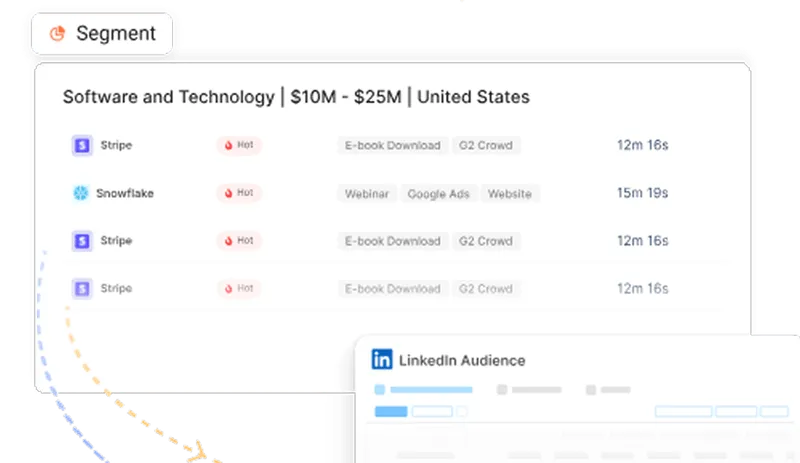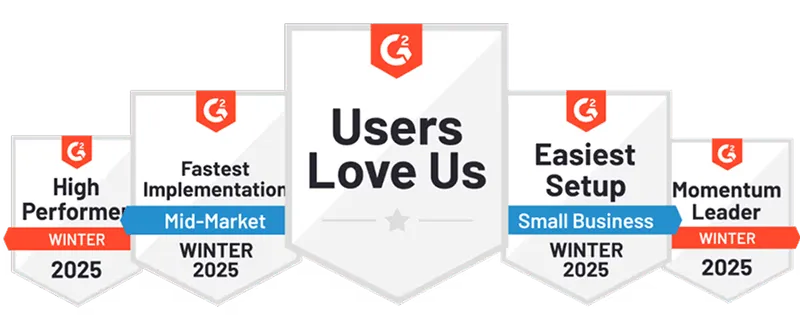7 Signs Your B2B Marketing Strategy Needs a Complete Solution Overhaul
Learn the key indicators that your B2B marketing solutions need updating, from stalled revenue to misaligned teams. Get actionable insights to revamp your strategy.
Has your revenue growth stalled? Are your sales teams working together hard but seeing fewer results? Are competitors catching up despite weaker products? These challenges are common for B2B companies relying on outdated marketing methods. Frustration mounts as marketing fails to generate quality leads, sales cycles lengthen, and your brand fades in a crowded market.
The solution? Recognize when your approach is faltering and transition to modern B2B marketing. By identifying the signs early, you can adjust your strategy, support your teams, and regain your competitive edge. This guide outlines the seven key indicators that your B2B marketing strategy needs a fresh, data-driven update.
TL;DR
- Revenue stalls and conversion rates drop when tactics no longer resonate.
- Lack of clear ROI and poor sales-marketing alignment signal a need for an overhaul.
- Outdated branding and rigid strategies fail to engage today’s buyers.
- Competitors’ superior visibility and engagement highlight strategic gaps.
If several of these signs resonate, it’s time to consider a comprehensive overhaul with modern B2B marketing solutions that align teams, clarify ROI, and drive sustainable growth.
7 Signs Your B2B Marketing Strategy Needs a Clear Solution
Sign 1: Plateaued Revenue and Stalled Growth
When revenue growth halts, it's a clear sign that your B2B marketing strategy needs reevaluation. Stagnant growth suggests that your current approach has reached its limits. To reignite growth, consider a comprehensive strategy overhaul that leverages data-driven insights and innovative marketing solutions, such as Funnel Conversion Optimization.
Sign 2: Declining Lead Quality and Conversion Rates
If your sales team spends more time on leads but closes fewer deals, it indicates that your B2B marketing isn't reaching the right audience. Poor lead quality means your campaigns attract browsers rather than buyers, wasting resources and frustrating your teams. Even if website traffic remains steady, a drop in conversion rates suggests a disconnect in messaging or a cumbersome process. To address this, refine your targeting, enhance your messaging, and ensure your strategy attracts and converts your ideal B2B customers. Tools like Intent Capture can help identify high-intent leads.
Sign 3: Unclear ROI and Ineffective Attribution
Struggling to measure marketing ROI or attribute results to specific campaigns is a red flag. Without clear metrics, it's challenging to justify marketing spend or understand which efforts drive success. Implementing robust analytics tools can provide the insights needed to optimize your strategy and demonstrate tangible results. Consider using content attribution to gain deeper insights into your marketing efforts.
Sign 4: Misalignment Between Marketing and Sales Teams
A significant indicator that your B2B marketing strategy needs adjustment is misalignment between marketing and sales teams. When these teams don't share goals or data, valuable leads can be lost. Marketing might generate leads that sales deem unqualified, leading to frustration and missed revenue targets.
For B2B companies, seamless teamwork is crucial. Marketing should deliver leads that align with sales' ideal customer profile, and sales should provide feedback on the quality of these leads. Frequent disagreements, unclear processes, or mixed messages to prospects signal the need to realign your strategy. Foster collaboration with shared goals and regular communication to unlock the full potential of your B2B marketing. Tools that have workflow Automations can streamline this process.
Sign 5: Outdated Brand Presence and Messaging
An outdated brand presence is a clear sign that your B2B marketing needs a refresh. Today's buyers research and compare options before engaging with sales. If your website, social media, and content appear outdated or inconsistent, prospects may question your relevance or expertise. Outdated messaging can miss the current needs of your audience, allowing more agile competitors to gain an edge. Regularly evaluate your brand and messaging to ensure they reflect your company's current value and position.
Sign 6: Inability to Adapt to Market or Buyer Changes
Markets and buyer behaviors evolve rapidly, especially in B2B industries. If your marketing strategy can't keep pace with new trends or shifts in buyer roles, you risk falling behind. For instance, if your campaigns target outdated personas or overlook new channels where buyers now spend time, you lose valuable opportunities. A rigid approach can also waste your budget on ineffective tactics. The best B2B marketing solutions are flexible, using data to detect changes early and adjust messaging, channels, and offers. If your team reacts slowly to market feedback or fails to engage new buyer types, it's a clear sign your strategy needs a complete overhaul to stay relevant and competitive. By tapping into the insights available through our Account Intelligence solution, you can pivot faster and engage the right accounts at the right time
Sign 7: Competitors Outperforming Your Marketing Efforts
If competitors consistently outperform you in brand visibility, lead generation, or customer engagement, it's time to rethink your B2B marketing. When rivals with similar products gain more market share, their strategy likely aligns better with current buyer needs. You might notice their content engaging more people, their messaging resonating well, or their use of new channels you haven't explored. Ignoring this can lead to lost revenue and a weakened brand.
Regularly benchmark your performance against competitors. If your results fall short despite similar resources, it's time to revamp your approach to regain your edge and ensure your marketing supports real business growth. Consider leveraging Marketing ROI tools to measure your effectiveness.
Actionable Insights to Revamp Your B2B Marketing Strategy
If your current B2B marketing results are lagging in low conversion rates, misaligned teams, or unclear ROI, it may be time for a full strategic reset. Here are proven, actionable steps to breathe new life into your strategy and drive performance:
1. Reassess Your Ideal Customer Profile (ICP)
Markets evolve, and so do your buyers. Re-evaluate your ICP by analyzing your best-performing accounts and identifying updated firmographic, technographic, and behavioral traits. Tools like Factors.ai can help enrich this data and uncover new segments worth targeting.
2. Conduct a Funnel-Wide Audit
Map out your buyer journey from first touch to closed deal and identify drop-off points. Utilize attribution platforms like Dreamdata or Factors to identify which stages or campaigns are underperforming. Then align content and campaigns to fill those conversion gaps.
3. Realign Sales and Marketing Around Shared Revenue Goals
Break down silos by implementing RevOps principles. Ensure both teams agree on definitions (e.g., MQLs vs. SQLs), share dashboards, and co-own pipeline targets. This alignment improves lead quality and shortens sales cycles.
4. Rebuild Content Strategy for Buyer Intent
Stop producing content for volume. Focus instead on intent-based content tailored to each stage of the buyer journey. Use SEO tools like Ahrefs or Semrush to identify what your target audience is actually searching for, and align assets like whitepapers, case studies, and product demos accordingly.
5. Shift to Account-Based Everything (ABX)
ABM isn’t just for enterprise. If you're selling high-value products, adopt an ABX approach, combining sales, marketing, and customer success to deliver coordinated, personalized outreach. Factors helps you with this process.
6. Upgrade Your Tech Stack for Scalability and Integration
Outdated or isolated tools slow your progress. Rebuild your stack with API-first platforms that integrate seamlessly, e.g., a headless CMS, a unified CRM, and analytics tools that support multi-touch attribution. Automate repetitive tasks to let teams focus on high-value work.
7. Create an Agile Testing Framework
Embed experimentation into your strategy. Use A/B testing and multivariate testing on messaging, CTAs, landing pages, and even sales sequences. Make data-backed decisions fast, and continually optimize based on real performance, not gut feel.
8. Invest in Training and Internal Enablement
Even the best tools and strategies fail without skilled users. Conduct regular training on systems, data literacy, and modern B2B tactics. Empower your team to act on insights, iterate campaigns, and drive continuous improvement.
When you apply these insights, you're not just patching up problems but laying the groundwork for scalable, measurable growth. A strategic overhaul doesn't need to be overwhelming; it just needs to be focused, data-driven, and aligned with real buyer behavior.
Final Thoughts: Adapting Your B2B Marketing for Better Results
Traditional B2B tactics often fail to sustain momentum, manifesting as stalled revenue and prolonged sales cycles. Declining lead quality and conversion rates frequently reflect misaligned targeting and messaging. Additionally, opaque measurement frameworks hinder accountability, making it challenging to justify budgets or attribute outcomes. When marketing and sales teams operate in isolation, prime prospects slip through gaps, intensifying friction and delaying deals.
A dated brand presence that misses the mark with today’s decision makers and inflexible strategies that lag behind buyer shifts further exacerbate performance issues. Moreover, competitors capturing superior visibility and engagement expose strategic deficiencies. To reverse these trends, companies must reevaluate their ideal customer profiles, conduct full-funnel audits, and synchronize sales and marketing around unified goals. Adopting an account-based outreach model, upgrading to an integrated technology stack, establishing iterative testing protocols, and investing in targeted team training empower businesses to reclaim relevance and achieve predictable growth.
See how Factors can 2x your ROI
Boost your LinkedIn ROI in no time using data-driven insights


See Factors in action.
Schedule a personalized demo or sign up to get started for free
LinkedIn Marketing Partner
GDPR & SOC2 Type II
.svg)









